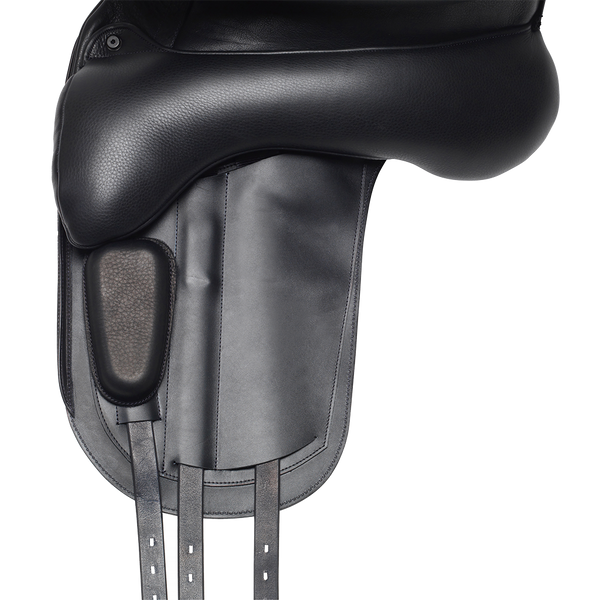Developed to maximise synchronicity between riders and horses with an 'uphill' conformation. This dressage saddle allows the rider to feel more balanced and 'at one' with their horse. The horse is able to move freely and improve his performance, thanks to a combination of the patented Fairfax Performance Panel and the rider's improved position.
The design and construction of the saddle's knee block, combined with the configuration of the seat, means that the knee has room to function effectively, allowing the rider's body to absorb the force of the horse's movement and allowing the pelvis to remain in a neutral position for longer.
- Deep rear, and slim front, gussets to provide a perfectly balanced platform for the rider on a horse with 'uphill' conformation.
- The knee block is constructed of multiple layers, including a shock-absorbing element that allows it to accommodate the forward movement of the rider's knee.
- This configurations offers the optimal level of rider support without restriction.
- The symmetry and balance of the rider's seat is improved when the pelvis is neutral.
- Seven physique options to suit individual rider anatomy (see chart below).
- Girthing options to optimize saddle stability.
- Changeable gullet bar.
- Available in 'Croc' and 'Plain' Trim
Patented Performance Panel

(Patent: GB2515079)
This saddle features the ground-breaking Fairfax Performance Panel which is scientifically proven to increase limb extension, joint flexion and gait symmetry.
The weight-bearing part of the panel under the rider’s seat is separated from the part under the rider’s knee (which lies over the horse’s shoulder). This allows the horse’s shoulder independence of movement, free from any restriction that a traditional panel could potentially cause – particularly beneficial on a horse with big shoulders or big shoulder movement
Adjustable Shoulder Blocks

Performance and World Class Dressage Saddles can be fitted with three thicknesses of changeable shoulder blocks.
Select the thickness of block according to rider preference - the thicker the block, the ‘closer’ it will bring the flap to the rider’s leg.
If a horse has asymmetrical shoulders, use the thicker block on the side with less muscle. This allows the rider to sit squarely while the horse is free to move underneath, building up muscle without restriction.






















